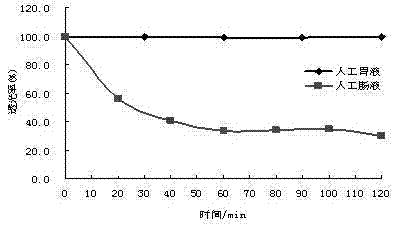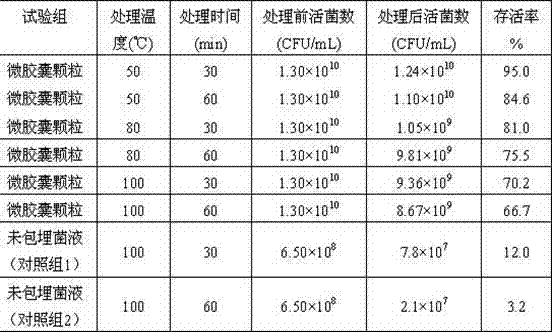Method for preparing butyric acid bacteria powder by microencapsulated propagation culture and application
A proliferation culture and microencapsulation technology, applied in the direction of microorganism-based methods, biochemical equipment and methods, applications, etc., can solve the problems that there are no patent reports on butyric acid bacteria, and achieve the prevention of intestinal diseases, low production cost, and tolerance Good effect of bile salt
- Summary
- Abstract
- Description
- Claims
- Application Information
AI Technical Summary
Problems solved by technology
Method used
Image
Examples
Embodiment 1
[0032] Embodiment 1: the preparation method of butyric acid bacteria microcapsule particles (1)
[0033] (1) Strain activation and expanded culture: Aseptically open the freeze-dried strain CGMCC No.1647, insert it into a test tube containing the activation medium, carry out static anaerobic culture, and cultivate it at 37°C for 18 hours, and then use a volume ratio of 2 % of the inoculum was transferred to fresh activation medium and cultured at 37°C for 24h. Microscopic examination shows that when more than 90% of the bacteria form spores, they are mature and activated 2 to 3 times. The seed bacteria suspension was transferred into the Erlenmeyer flask containing the fermentation medium with the inoculum amount of 1%-10% (V / V), and the liquid volume of the Erlenmeyer flask was 90% (V / V), and it was placed in a constant temperature incubator at 37°C Cultivate for 22-24 hours.
[0034] Butyric acid bacteria seed activation medium consists of the following raw materials and w...
Embodiment 2
[0041] Embodiment 2: the preparation method of butyric acid bacteria microcapsule particles (two)
[0042] (1) Strain activation and expanded cultivation are the same as in Example 1.
[0043] (2) Microencapsulation embedding: prepare sodium alginate with a weight percent concentration of 4.0%, sodium lactate at 0.3%, gelatin at 0%, and soluble starch at 0.5%, and mix them to obtain a microcapsule wall material. The solvent used is for deionized water. A calcium chloride deionized aqueous solution with a concentration of 3.0% by weight was prepared and sterilized for use.
[0044] According to the volume ratio of bacterial liquid: wall material = 1:3.5, the mixed glue of wall material and bacterial liquid is prepared. After fully stirring, the mixed liquid is sprayed to the sterilized concentration of magnetic stirring by using a high-voltage electrostatic capsule forming device. 200 microcapsules of 2-3 mm can be prepared per ml of bacterial liquid in 3.0% calcium chloride ...
Embodiment 3
[0046] Embodiment 3: the preparation method of butyric acid bacteria microcapsule particles (three)
[0047] (1) Strain activation and expanded cultivation are the same as in Example 1.
[0048] (2) Microencapsulation embedding: prepare sodium alginate with a concentration of 2.0% by weight, sodium lactate at 0.5%, gelatin at 1.0%, and bentonite at 0.5%, and mix them to obtain wall materials for microcapsules. The solvent used is Deionized water. Calcium chloride deionized aqueous solution with a concentration of 2.5% by weight was prepared and sterilized for use.
[0049] According to the volume ratio of bacterial liquid: wall material = 1:5, prepare the mixed glue of wall material and bacterial liquid. After fully stirring, use high-voltage electrostatic capsule forming device to spray the mixed liquid to the sterilized concentration of magnetic stirring. In 2.5% calcium chloride deionized aqueous solution, form microcapsules of 2-3 mm, stand and solidify for 22-24 hours, ...
PUM
| Property | Measurement | Unit |
|---|---|---|
| thickness | aaaaa | aaaaa |
| transmittivity | aaaaa | aaaaa |
| transmittivity | aaaaa | aaaaa |
Abstract
Description
Claims
Application Information
 Login to View More
Login to View More - R&D
- Intellectual Property
- Life Sciences
- Materials
- Tech Scout
- Unparalleled Data Quality
- Higher Quality Content
- 60% Fewer Hallucinations
Browse by: Latest US Patents, China's latest patents, Technical Efficacy Thesaurus, Application Domain, Technology Topic, Popular Technical Reports.
© 2025 PatSnap. All rights reserved.Legal|Privacy policy|Modern Slavery Act Transparency Statement|Sitemap|About US| Contact US: help@patsnap.com



